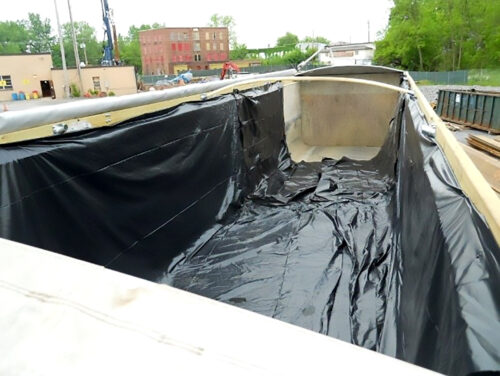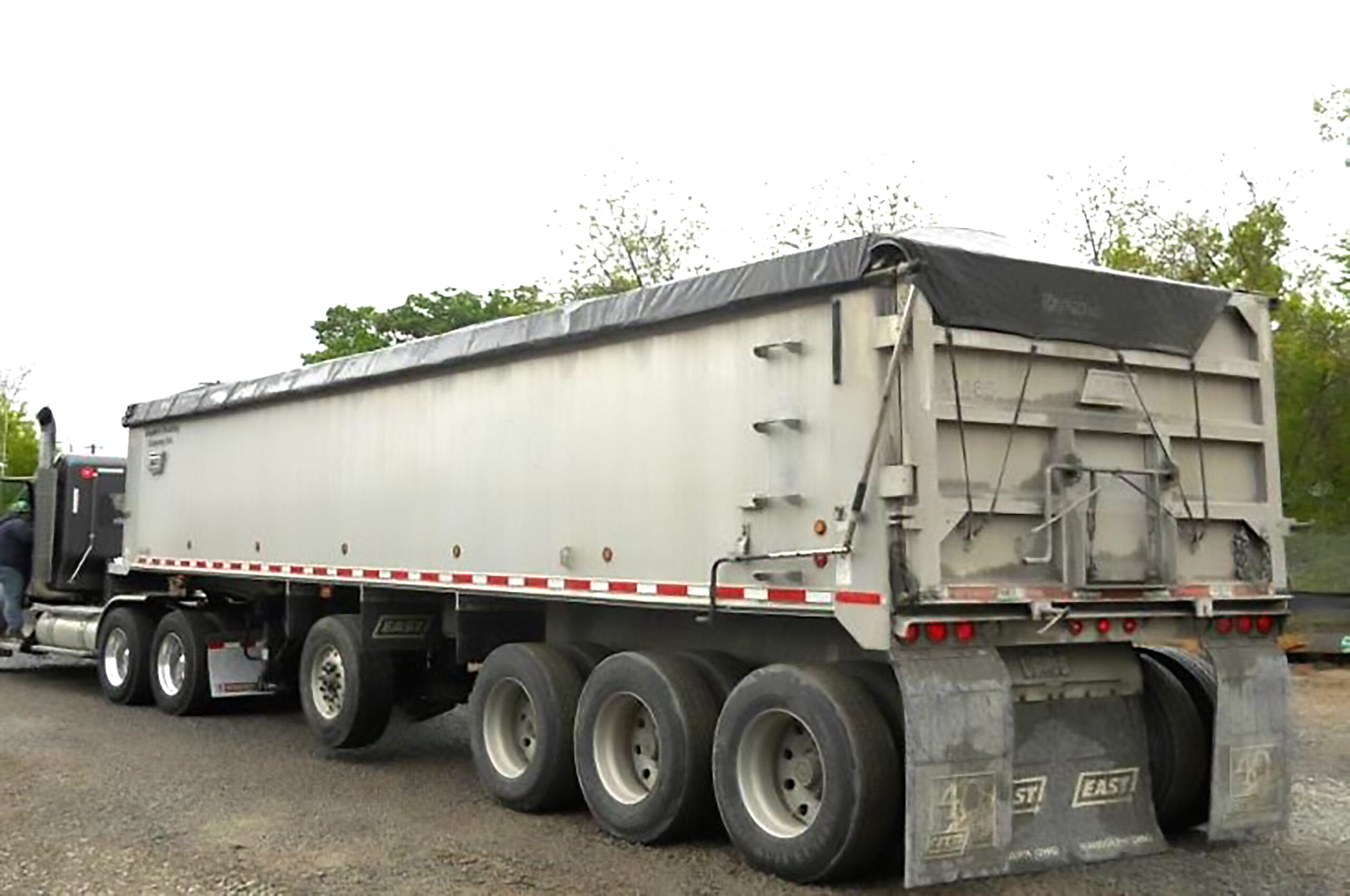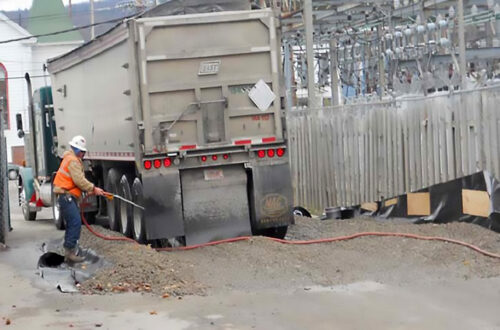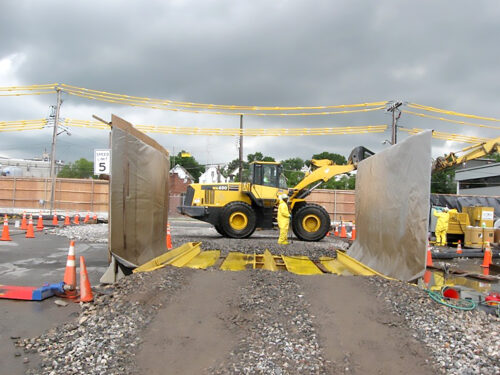On-site Soil Management
On-site soils exhibiting the following will require excavation followed by treatment and on-site management or off-site disposal at an appropriate regulated facility:
- Grossly contaminated soil;
- Soil determined to be hazardous waste through laboratory analysis;
- Soil containing visually identifiable waste or non-aqueous phase liquids;
- Soil containing arsenic over 16 parts per million (ppm);
- Soil containing total polycyclic aromatic hydrocarbons (PAHs) over 500 ppm;
- Soils which exceed the Protection of Groundwater Soil Cleanup Objectives for contaminants found in site groundwater above standards; and/or
- Soils that create a nuisance condition such as distinct odors or staining.
On-site soils, present within one foot of finished grade, which exceed the Restricted Use Soil Cleanup Objectives for the Protection of Public Health for Industrial Use, or in certain areas Commercial Use, as defined by 6 NYCRR Part 375-6.8 will be contained using a vegetated cover system or other approved fill, placed over a demarcation layer.
What does soil treatment consist of?
The main types of treatment that may be employed at the Site are solidification and stabilization. Solidification is a process that binds the soil particles creating a low permeability mass. The contaminated soil is mixed with solidifying agents, like cement or other binding agents. The soil and binding agents are mixed to produce a solidified mass resulting in a low permeability monolith. The resulting solid mass reduces or eliminates mobility of contamination and reduces or eliminates the soil as a source of groundwater contamination. Stabilization is a process that uses a stabilizing agent which chemically changes the contamination in the soil to make it less soluble. This treatment changes the contamination from a soluble form to a stable, insoluble compound to reduce or eliminate the matrix as a source of groundwater contamination. Other types of soil treatment include biological treatment, chemical oxidation, and physical methods, such as soil washing.
How will excavated soils be managed on-site?
Excavated soils meeting screening criteria will be transported to a Solid Waste Corrective Action Management Unit (CAMU) for disposal.
What is a CAMU?
A Solid Waste Corrective Action Management Unit (CAMU) is an area within a facility or site that is used for the disposal of eligible wastes in support of a implementing a corrective action or cleanup. The CAMU will be designed in accordance with New York State (NYS) requirements for solid waste landfills and will include an engineered liner system under the waste, an engineered cap over the waste once completed, and a leachate collection and treatment system to remove liquids generated from the waste and prevent them from reaching the environment. A CAMU is used only for managing CAMU-eligible wastes at the facility being remediated.
A CAMU must be located within the property where the wastes to be managed in the CAMU originated. There are several ways this on-site disposal option facilitates the implementation of a reliable, effective, protective, and cost-effective remedy:
- Disposal areas will be protected with a liner. The requirement for a liner would be predicated on the concentrations and leachability of the waste going into the CAMU;
- Soil testing and concentration limit control. Previous testing has indicated that the arsenic-contaminated soil does not have the propensity to leach arsenic or other contaminants into the groundwater. In addition, a maximum soil concentration would be set for on-site disposal. The CAMU will be designed to incorporate proven and innovative treatment technologies (such as soil washing, stabilization, or solidification) to significantly reduce the toxicity and mobility of remediation waste prior to placement into the on-site cell;
- Successful construction and effective maintenance of the CAMU cap. A well-built cap would prevent runoff from being contaminated and prevent soil from eroding. A properly built and maintained CAMU would be very effective and reliable at containing and isolating the waste long-term; and
- Design provisions to reduce infiltration through the berms and roads by extending cap membranes up berm slopes. Prior to performing a detailed remedial design, a pre-design investigation will be performed to verify that uncovered surfaces are suitable for passive recreational use and minimize the potential for water to percolate through waste materials.
What are the screening criteria?
Excavated soils from known contaminated areas will need to meet the following screening criteria before disposal in the on-site CAMU:
- Soil identified as a hazardous waste will not be permitted in the CAMU without treatment to render the soil or waste non-hazardous; and
- Soil containing liquid waste will not be permitted in the CAMU without dewatering or stabilization to soak up free moisture.
How will on-site soils be managed during the cleanup?
Soils will be excavated under a DEC approved work plan that will include the following measures to prevent further spread of impacted soil:
- Implementation of a health and safety plan (HASP) to reduce work related injury;
- Implementation of a community air monitoring program (CAMP) and dust suppression techniques to prevent airborne migration of impacted soil particles and odors;
- Equipment decontamination and appropriate lining and tarping of transportation equipment to limit the spread of impacted soil during transportation; and
- Implementation of a stormwater pollution prevention plan (SWPPP) to mitigate stormwater runoff from excavated areas or areas containing stockpiled soil.
Excavated soils meeting screening criteria will be transported to a Solid Waste Corrective Action Management Unit (CAMU) for disposal.
How will on-site soils be managed after the cleanup?
On-site soils will be subject to an Excavation Work Plan (EWP) once the cleanup has been completed. The EWP is part of the Site Management plan and contains requirements for:
- Notification to the DEC prior to any ground intrusive work;
- Removal, management, and handling of soil encountered during excavation; and
- Handling and quality of backfill brought to the Site.
Off-site Soil Disposal
On-site soils exhibiting the following will require excavation followed by treatment and on-site management or off-site disposal at an appropriate regulated facility:
- Grossly contaminated soil;
- Soil determined to be hazardous waste through laboratory analysis;
- Soil containing visually identifiable waste or non-aqueous phase liquids;
- Soil containing arsenic over 16 parts per million (ppm);
- Soil containing total polycyclic aromatic hydrocarbons (PAHs) over 500 ppm;
- Soils which exceed the Protection of Groundwater Soil Cleanup Objectives for contaminants found in Site groundwater above standards; and/or
- Soils that create a nuisance condition such as distinct odors or staining.
On-site soils, present within one foot of finished grade, which exceed the Restricted Use Soil Cleanup Objectives for the Protection of Public Health for Industrial Use, or in certain areas Commercial Use, as defined by 6 NYCRR Part 375-6.8 will be contained using a vegetated cover system or other approved fill, placed over a demarcation layer.
How will excavated soils sent off-site be managed?
While the method of transportation for excavated soil will be determined during the remedial design, the DEC’s preferred mode of transportation is rail since it reduces truck traffic, reduces greenhouse gases, utilizes rail facilities are located near the site, and is in line with previously received community comments. Alternatively, excavated soil may be trucked to approved disposal facilities using approved trucking routes.
In the event transportation to an off-site facility is carried out using trucks, pre-approved trucking routes will be determined to minimize proximity to residential neighborhoods and schools. Transportation of impacted soil will be completed by authorized haulers in lined and tarped truck beds to prevent migration of impacted soil.
How will the excavated soils be transported?
While the method of transportation for excavated soil will be determined during the remedial design, the DEC’s preferred mode of transportation is rail since it reduces truck traffic, reduces greenhouse gases, utilizes rail facilities are located near the site, and is in line with previously received community comments. Alternatively, excavated soil may be trucked to approved disposal facilities using approved trucking routes.
In the event transportation to an off-site facility is carried out using trucks, pre-approved trucking routes will be determined to minimize proximity to residential neighborhoods and schools. Transportation of impacted soil will be completed by authorized haulers in lined and tarped truck beds to prevent migration of impacted soil.


Example of a lined truck and tarp-covered truck ready for off-site disposal
Prior to leaving the site, trucks are washed down and decontaminated to avoid off-site transport of impacted soil.


Example of a decontamination station and truck wheel decontamination process prior to leaving the Site
Clean Backfill
Backfill material will be used to establish design grades on-site, fill void areas and establish cover systems where previously impacted soil has been removed. Backfill material may consist of:
- On-site soils which do not exceed the SCO criteria may be used as backfill beneath a cover system;
- On-site soils which do not exceed the Protection of Groundwater Soil Cleanup Objectives may be used as backfill beneath a cover system, including beneath the groundwater table; and/or
- Clean imported soil from a DEC approved source may be used as backfill beneath a cover system or as part of the cover system. Clean imported soil used as part of the cover system will meet the appropriate Soil Cleanup Objectives based on future industrial or commercial uses.


